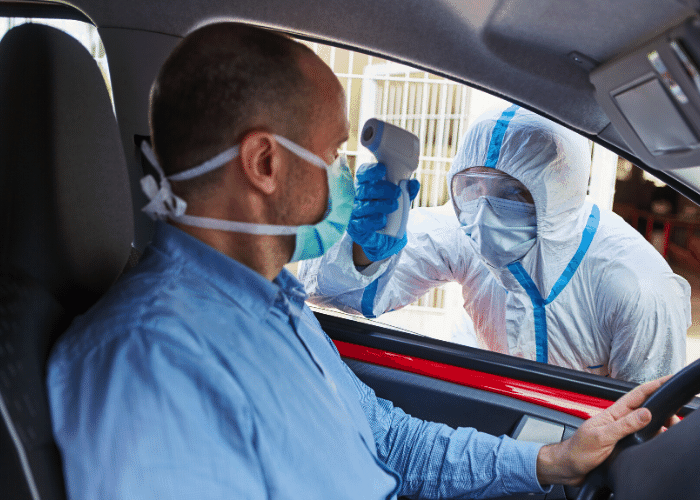COVID-19 has certainly raised critical issues facing the healthcare industry, especially from the perspective of worker safety, critical hospital infrastructure and equipment supply. News headlines across the country warn that, despite prospects for less restrictive stay-at-home orders, the COVID-19 pandemic continues to run its course. Dr. Anthony Fauci, Director of the National Institute of Allergy and Infectious Disease said this of the virus’ progression: “It is highly likely that we will have—I don’t know whether you want to call it a second wave—but we will have a return of infections as we get into the next season.” Even through these grim headlines, healthcare professionals and hospital administrators, already working around the clock, are starting to plan for a second wave COVID-19 outbreak.
Given COVID-19 is a respiratory virus, Respiratory Protection Program (RPP) managers have the difficult task of finding ways to keep their colleagues safe from infection. Here are four respiratory protection initiatives that can be improved over the coming months to help hospitals prepare for the impending second wave of COVID-19:
1. Prioritize respiratory fit tests for all NIOSH-certified respirators.
The lack of PPE and N95 masks specifically have been widely reported as a key challenge facing healthcare workers. But the availability of N95 masks is only a part of the problem. An N95 mask is only as good as proper sizing and donning, or putting the mask on, to ensure a good “fit” or seal of the mask to the face. There have been reports of replacement masks being used without a fit test. Regardless of previous fit testing, any new mask requires a new fit test to ensure the best possible seal to the wearer’s face. Besides being a violation of OSHA rules, this is an unsafe practice since there is no assurance that the new respirator fits properly.
2. Make sure any new N95 respirators are OSHA-certified and have been tested properly.
Given the global shortage of N95 respirators for healthcare workers, many companies outside of the PPE industry have leveraged their manufacturing expertise to create N95 respirators. These respirators must be filter tested and certified by OSHA before they can be marketed as N95 certified. As manufacturers from different industries and countries ramp up production of N95 respirators to meet the surge in demand, it is important to ensure that the respirators are properly certified and tested under OSHA standards (29 CFR § 1910.134).
3. Put quality control measures in place to check ventilator air flow and ensure effectiveness.
A tremendous industrial response has occurred to increase the supply of ventilators from a variety of manufacturers. Some of these are traditional manufacturers but many new players have also developed equipment and gained approval through the FDA on a permanent or an Emergency Use Authorization. These companies may not have established service and calibration processes. Moving forward, it will be critical to have ventilators calibrated and serviced, ensuring proper therapeutics, resulting in maximum benefit and patient safety.
4. Create more isolation rooms that are properly pressurized to keep contaminants in, or out.
The healthcare industry has done a tremendous job increasing ICU room capacity using a variety of methods. Of critical concern is that the virus cannot spread beyond the patient’s ICU room and throughout the hospital. To this end, isolation rooms must be pressurized in such a way that air is strictly drawn into the patient room. While temporary measures are meeting a critical need by using large fans and filters, this solution is energy inefficient and is not sustainable long term. Permanent solutions must be explored once we proceed past the first wave of outbreak. Facilities should examine creating convertible rooms, which have the capability to measure and close-loop control the pressure differential in the room ensuring healthcare worker and patient safety. The technology exists and should be considered as we prepare for future waves of COVID-19 – and future viruses.
While there are no guarantees regarding when this first round of virus will subside and what the future will hold, the current situation has highlighted areas where we, as an industry, can improve. To prepare, we need to protect our workers with properly fitted and certified respiratory protection, make certain that our patients are provided quality medical equipment, and consider how to equip our hospitals with methods to expand ICU beds in critical times.
About the Author:
Dr. Thomas Kennedy is president of TSI Incorporated, an industry leader in particle measurements and precision instrumentation. Dr. Kennedy earned his Ph.D. in Electrical Engineering from the University of Illinois. Prior to leading TSI, Tom has extensive experience working with medical companies such as GE Medical Systems and Camtronics, as well as GE Corporate Research. TSI Incorporated is a leading provider of respirator fit testing instruments, room pressure monitors and controls, flow meters critical to the production and proper maintenance of ventilators, as well as filter testing equipment to ensure PPE is within the target range to filter out harmful particles. TSI has been in business more than 50 years with offices around the globe.
The Editorial Team at Healthcare Business Today is made up of skilled healthcare writers and experts, led by our managing editor, Daniel Casciato, who has over 25 years of experience in healthcare writing. Since 1998, we have produced compelling and informative content for numerous publications, establishing ourselves as a trusted resource for health and wellness information. We offer readers access to fresh health, medicine, science, and technology developments and the latest in patient news, emphasizing how these developments affect our lives.








